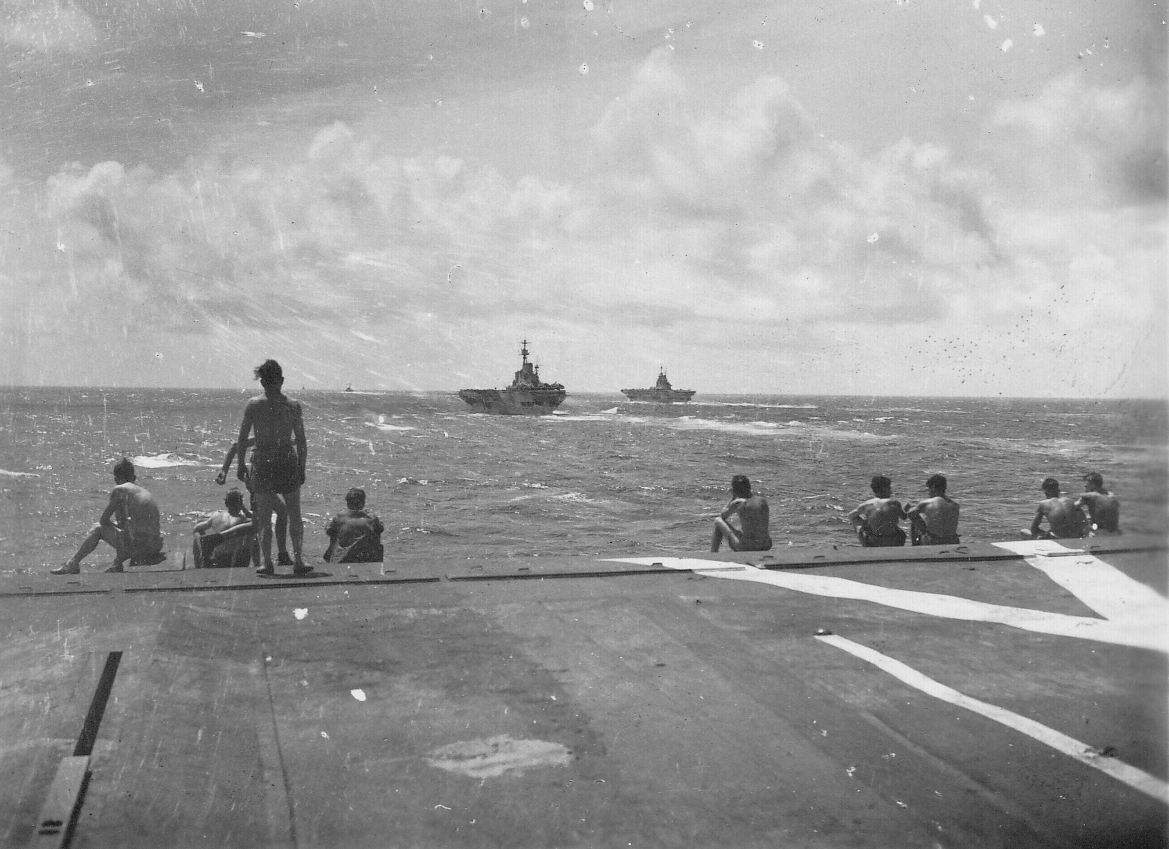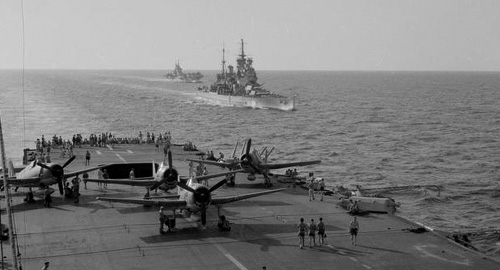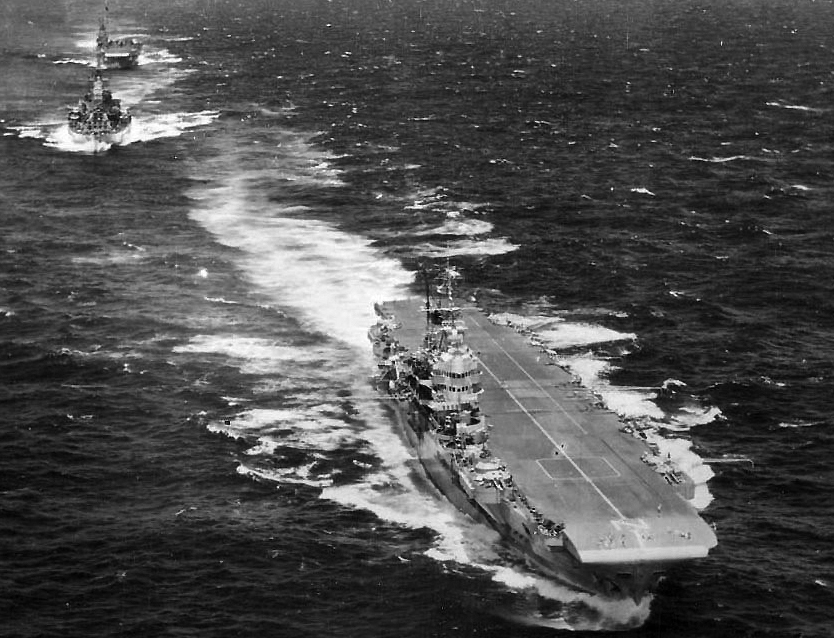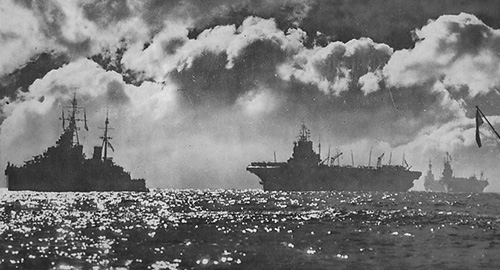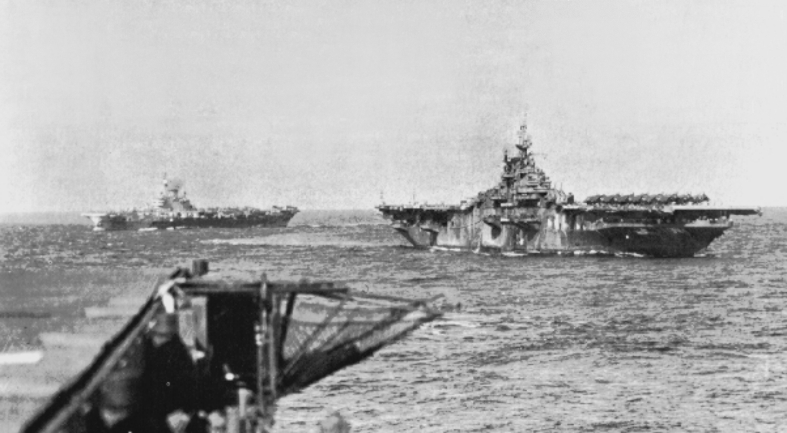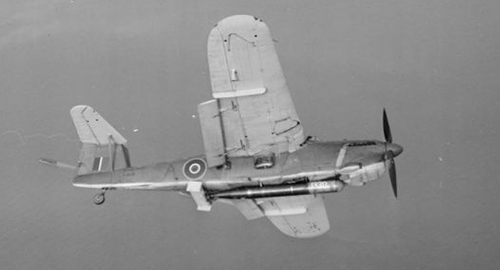The untold story of the Royal Navy's struggle to invent carrier warfare
Great Britain was breaking new ground with the first fleet to deploy carrier air power in a high-intensity war in 1939.
Captains, crews, pilots and admirals were making things up as they went along.
And the world was watching.
Anti-submarine hunter-killer groups? Costly failure.
Surprise strikes against major harbours? Resounding success.
Close escorts for convoys running the gauntlet to Malta?
It was the ultimate test of doctrines determined during the disruptive 1920s and 30s.
So why have the experiments, endeavours and endurance of the Royal Navy’s carrier operations seemingly been lost to history?
This website seeks to give you a detailed account of the actions in which Britain's radical armoured carriers sustained damage, what that damage was, and how well these ships met both design requirements and unexpected adaptations.
SCROLL DOWN FOR:
Doctrine Determined - The thinking behind the armoured carrier designs
Baptism of Fire - Battle and damage overvews for actions in the Mediterranean
Damage Detailed - Original damage report documents, diagrams, photos
Firestorm in the East - Battle reports for the Indian and Pacific Oceans
Between Ice & Fire- Battle and damage reports for the British Pacific Fleet
Fire in the Sky - Understanding the key aircraft of the Fleet Air Arm
Doctrine determined
The 1930s was a time of explosive technical advance and rapidly shifting strategic and tactical demands. War games had revealed the immense power and intrinsic vulnerability of the fleet carrier.
What did the Royal Navy need?
Overview: Striker or Survivor?
+ Admiralty Document 1: Open-sided versus closed hangars
+ Admiralty Document 2: Open-sided versus closed hangars
illustrious Class
Born in an era of uncertainty, treaty and constant change, the armoured carrier was as radical as it was controversial.
Armoured Carrier Design
+Specifications | +Staff Requirements
HMS INDOMITABLE
Aircraft and radar technology was developing fast. Suddenly, aircraft numbers seemed relevant again.
Implacable class
Delays due to war shortages enabled the design to be revisited. But, with refinements came new restrictions.
HMS UNICORN
The concept, design and deployment of this fleet support carrier represents a 'missing link' in the understanding of RN doctrine.
Audacious Class
More and bigger aircraft. Better protection. Greater endurance. Putting it all together was an audacious proposal.
IJN Taiho
Did the concept of armoured carriers apply to the Pacific Theatre? Japan certainly thought so, fielding its own in 1944.
USS MIDWAY
The armoured flight deck debate raged fiercely within the USN through the 1930s and 1940s. The CVB was its outcome.
Doctrine Dichotomy | The ‘Battle’ Carrier
Baptism of Fire
The reality of war in 1939 proved harsher than anyone imagined. Aircraft were more effective than anticipated. Anti-aircraft technology simply was not up to the job. Radar was turning everything on its head. The armoured carriers had to fight their way through - and survive - the brutal lessons of this tumultuous time.
BATTLE OF TARANTO
In just one night, HMS Illustrious changed the balance of the war and cemented the aircraft carrier at the core of the battlefleet.
OPERATION EXCESS
Operating alone and with minimal escort, HMS Illustrious survived the worst bomb damage of the war.
The Battle | The Illustrious Blitz | Damage Overview
+Gunnery Report | +Captain's Report | +X Fliegerkorps
FORMIDABLE PRESENCE
Five months of intensive operations, including a fleet action, pushed HMS Formidable and her aircraft beyond the limit.
OPERATION MAQ3
The success of a carrier cannot be separated from that of its aircraft. Such was the case with HMS Formidable in May 1941.
OPERATION PEDESTAL
Three fleet carriers versus Italy and Germany's land based might. HMS Indomitable would bear its brunt.
The Battle | Damage Overview
+Admiral's Report | + Damage Report
+ HMS Victorious Report | + HMS Indomitable Report
OPERATION HUSKY
Operating close to Sicily in support of invasion forces, HMS Indomitable found herself again in Axis sights.
Damage Detailed
Many books brush over the damage dealt to HMS Illustrious, Formidable and Indomitable in the early war years. Others get it wrong. While Top Secret for a considerable time, the Damage Report findings, drawings and testimony are now easily available. The detail they contain casts new light on the ships and their capabilities.
ILLUSTRIOUS BOMBED
HMS Illustrious' deck armour was defeated: but it took a 1000kg (2200lb) bomb to do the deed.
FORMIDABLE BOMBED
HMS Formidable took two blows from 1000kg (2200lbs) bombs, but remained an operational carrier.
INDOMITABLE BOMBED
At the height of the battle to get the Pedestal convoy through to Malta, Stukas delivered a triple-blow to HMS Indomitable.
INDOMITABLE TORPEDOED
Quick counter-flooding, on the captain's initiative, saved HMS Indomitable from the same fate as Ark Royal.
famous photo's enduring mystery
It's one of the war's most dramatic photographs: Illustrious's steaming and smoking flight deck as the devastating attacks of January 10, 1941, unfold.
Given what we know, what does this picture actually show?
Firestorm in the East
The Royal Navy was never supposed to have been fighting in the Arctic, Atlantic and the Mediterranean at the same time . Now things had gotten so much worse - with the loss of HMS Prince of Wales and Repulse, and the Imperial Japanese navy threatening the arterial supply lines of the Indian Ocean.
Britain's 'Midway'
In the dark days of 1942, Britain and Japan came within 100 miles of changing the course of history.
Operation C: The Battle for Ceylon
+Admiral's Report | +RN IJN Carrier Comparison
'USS ROBIN'
The ship that never was: HMS Victorious was to be 'loaned' to the United States Pacific Fleet in 1943 to plug a carrier gap.
HMS Victorious' USN Deployment
+Proceedings | +Captain's Report
+832 Squadron Report | +USN Liaison Report
When 'Lusty' met 'Sara'
HMS Illustrious, with a fresh purpose and new aircraft, was to be 'schooled' in Pacific warfare by USS Saratoga.
Operations Diplomat, Cockpit and Transom
+Liaison Officer's Report | +Commander Clifton, USN
'CLUB RUNS'
A series of 'working-up' missions in the Indian Ocean would expose the RN's lack of experience in strike carrier operations.
THE FAA's FINEST HOUR
The freshly formed British Pacific Fleet had to prove its worthiness. Japan's remaining oil refineries were an ideal test.
Operations Meridian I & II
+Air Commander's Report | +Admiral's Report
Between Fire & Ice - The British Pacific Fleet
With the Italian fleet surrendered and the remaining units of the German navy neutralised, Britain was forced to turn her attention towards her responsibilities in the Far East. But two questions were at the forefront of the United States' mind: Could the British Pacific Fleet sustain extended operations?
Were the armoured aircraft carriers up to the task?
Task Force 57
As the fire and ice of politics clashed around them, the commanders and crew of the BPF prepared to fight.
ICEBERG I
The wait was over. The British Pacific Fleet would now face its first test in the Pacific - including the dreaded kamikaze.
ICEBERG OOLONG
The US fleet at Okinawa was being hammered. So Admiral Spruance sent his 'ready reserve' on a desperate diversion.
ICEBERG Redux
Stretched to the limit by its first experience in Pacific warfare, the British Pacific Fleet volunteered for an extra round
Leyte Layover
It had taken a mad scramble to assemble a functional Fleet Train. Now it worked frantically to reprovision and repair the carriers.
ICEBERG II
The final stint off Sakishima Gunto would present Task Force 57 with its most intense kamikaze attack yet.
READYING & REPAIR
With the lessons of ICEBERG learnt, the British Pacific Fleet raced to prepare itself for the final act of World War II.
Overview *
ECLIPSE OF THE RISING SUN
Now fully up to speed alongside the USN in Pacific warfare, the armoured carriers took their place in the bombardment of Japan.
The Battle *
Kamikaze - Pacific Firestorm
Britain's armoured carriers had been optimised to fight in the close confines of the Mediterranean and North Sea. It is ironic that their armour and fire suppression systems proved most successful in the Pacific.
HMS Formidable: May 4
HMS Formidable would suffer the most severe kamikaze strike made against an armoured carrier days after joining TF 57.
HMS Indomitable
The Flagship of the British Pacific Fleet carrier squadron was hit by glancing blows twice, once on April 1st and again on May 4
HMS Formidable: May 9
Five days after her first blow, Formidable would receive a second direct hit on her armoured deck from a suicide bomber.
HMS Indefatigable
On April 1, sweepers 'manned their brooms' after a kamikaze direct hit and Indefatigable was back in action within 37 minutes.
HMS Victorious
HMS Victorious' violent manoeuvers under Captain Denny turned two kamikaze death-dives into glancing blows.
HMS Illustrious
This tired old veteran of the worst the war could throw at a ship suffered a kamikaze near-miss which re-opened old wounds.
Fire in the Sky - The Fleet Air Arm
The consequences of the RAF's control over Britain's naval aviation during the 1930s was to have repercussions throughout World War II in the transition from big guns to air wings. The formation of the Fleet Air Arm was barely in time to get the Royal Navy's carrier air power program back on track.
+ USN Fighter Direction Liaison Officer’s Report, 18 April, 1945
Fairey Fulmar
It was a stop-gap emergency program that produced results: The Fulmar entered service at exactly the right time to stem the tide.
GRUMMAN MARTLET
Against the odds, Grumman's tubble little 'cat' clawed its way back from obscurity to 'hold the line' and set new standards
HAWKER SEA HURRICANE
The RAF considered them obsolete cast-offs. But the FAA proved Hawker's stoic defender still had some fight left.
Supermarine Seafire
Those who flew it, loved it. Those who didn't, loathed it. The Supermarine Seafire was as controversial as it was lethal.
Development | Variants | Service
+Seafires 'drop in' on USS Essex
Fairey firefly
Delayed by disaster and politics, the two-seat Firefly emerged as the predecessor to a whole generation of strike fighters.
























